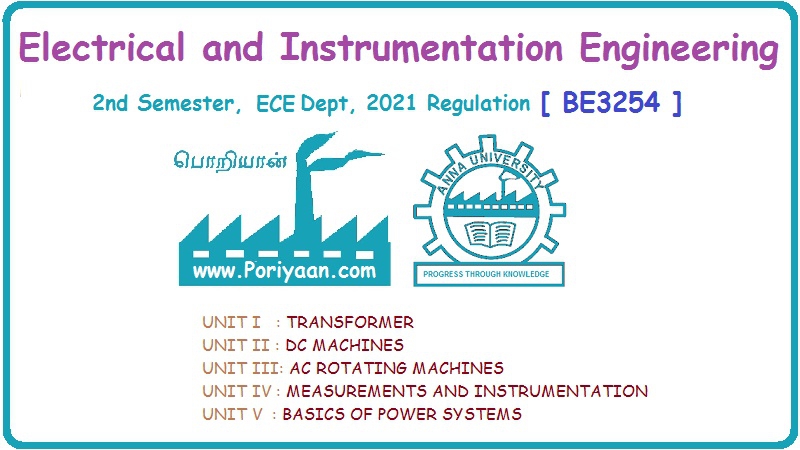Electrical and Instrumentation Engineering: Unit III: AC Rotating Machines
Methods of Starting Synchronous Motor
As seen earlier, synchronous motor is not self-starting. It is necessary to rotate the rotor at a speed very near to synchronous speed. This is possible by various method in practice.
METHODS OF STARTING SYNCHRONOUS MOTOR
As
seen earlier, synchronous motor is not self-starting. It is necessary to rotate
the rotor at a speed very near to synchronous speed. This is possible by
various method in practice. The various methods to start the synchronous motor
are:
1.
Using Pony Motors
2.
Using Damper Winding
3.
As a slip ring induction motor
4.
Using small d.c. machine coupled to it.
1. Using Pony Motors
In
this method, the rotor is brought to the synchronous speed with the help of
some external device like small induction motor. Such an external device is
called 'pony motor'.
Once
the rotor attains the synchronous speed, the d.c. excitation to the rotor is
switched on. Once the synchronism is established pony motor is decoupled. The
motor then continues to rotate as synchronous motor.
2. Using Damper Winding
In
a synchronous motor, in addition to the normal field winding, the additional
winding consisting of copper bars placed in the slots in the pole faces. The
bars are short circuited with the help of end rings. Such an additional winding
on the rotor is called damper winding. This winding as short circuited, acts as
a squirrel cage rotor winding of an induction motor. The schematic
representation of such damper winding is shown in the Figure 3.56.

Once
the rotor is excited by a three phase supply, the motors starts rotating as
induction motor at sub synchronous speed. Then d.c. supply is given to the
field winding. At a particular instant motor gets pulled into synchronism and
starts rotating at a synchronous speed. As rotor rotates at synchronous speed,
the relative motion between damper winding and the rotating magnetic field is
zero. Hence when motor is running as synchronous motor, there can not be any
induced e.m.f. in the damper winding. So damper winding is active only at
start, to run the motor as an induction motor at start. After wards it is out
of the circuit. As damper winding is short circuited and motor gets started as
induction motor, it draws high current at start so induction motor starters
like star-delta, autotransformer etc. used to start the synchronous motor as an
induction motor.
3. As a Slip Ring Induction Motor
The
above method of starting synchronous motor as a squirrel cage induction motor a
squirrel cage induction motor does not provide high starting torque. So to
achieve this, instead of shorting the damper winding, it is designed to a from
a three phase star or delta connected winding. The three ends of this winding
are brought out through slip rings. An external rheostat then can be introduced
in series with the rotor circuit. So when stator is excited, the motor starts
as a slip ring induction motor and due to resistance added in the rotor
provides high starting torque. The resistance is then gradually cut off, as
motor gathers speed. When motor attains speed near synchronous. d.c. excitation
is provided to the rotor, then motors gets pulled into synchronism and starts
rotating at synchronous speed. The damper winding is shorted by shorting the
slip rings. The initial resistance added in the rotor not only provides high
starting torque but also limits high in rush of starting current. Hence it acts
as a motor resistance starter.
The
synchronous motor started by this method is called a slip ring induction motor
is shown in the Figure 3.57.

It
can be observed from the Figure 3.57 that the same three phase rotor winding
acts as a normal rotor winding by shorting two of the phases. From the positive
terminal, current 'I' flows in one of the phases, which divides into two other
phases at start point as 1/2 through each, when switch is thrown on d.c. supply
side.
4. Using Small D.C. Machine
Many
a times, a large synchronous motor are provided with a coupled d.c. machine.
This machine is used as a d.c. motor to rotate the synchronous motor at a
synchronous speed. Then the excitation to the rotor is provided. Once motor
starts running as a synchronous motor, the same d.c. machine acts as a d.c.
generator called exciter. The field of the synchronous motor is then excited by
this exciter itself.
Electrical and Instrumentation Engineering: Unit III: AC Rotating Machines : Tag: : - Methods of Starting Synchronous Motor
Related Topics
Related Subjects
Electrical and Instrumentation Engineering
BE3254 - 2nd Semester - ECE Dept - 2021 Regulation | 2nd Semester ECE Dept 2021 Regulation
